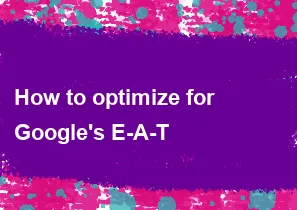How to optimize for Google's E-A-T

Google's E-A-T stands for Expertise, Authoritativeness, and Trustworthiness, and it is a set of guidelines that Google uses to assess the quality of a website and its content. Optimizing for E-A-T is important for improving your website's visibility in search engine results. Here are some strategies to optimize for E-A-T:
Content Quality:
- Create high-quality, relevant, and informative content.
- Demonstrate expertise in your field by providing in-depth and accurate information.
- Regularly update your content to ensure it stays current and relevant.
Authorship:
- Clearly attribute content to specific authors and experts in the field.
- Include author bios with details about their expertise and credentials.
- Establish the author's credibility by showcasing their expertise through relevant qualifications, experience, and accomplishments.
Expertise:
- Showcase the expertise of your content creators, contributors, and the organization as a whole.
- Provide evidence of your team's qualifications, certifications, and relevant experience.
- If applicable, highlight any awards, accolades, or industry recognition your team has received.
Authority:
- Build authority by getting mentions and backlinks from other reputable websites in your niche.
- Use social proof, such as testimonials, case studies, or endorsements, to demonstrate authority.
- Establish a strong presence on social media and other platforms related to your industry.
Trustworthiness:
- Ensure that your website has a professional design and is easy to navigate.
- Display clear contact information, including a physical address, on your website.
- Use secure protocols (https) to protect user data.
- Implement trust signals, such as security badges and customer reviews.
Backlinks:
- Focus on building high-quality backlinks from reputable websites in your industry.
- Avoid spammy or low-quality backlinks, as they can negatively impact your site's trustworthiness.
User Experience:
- Prioritize a positive user experience with a mobile-friendly design, fast loading times, and easy navigation.
- Minimize intrusive ads and ensure that the main content is easily accessible.
Transparency:
- Be transparent about your business, its mission, and how you operate.
- Clearly disclose any potential conflicts of interest or affiliations that may influence your content.
Regular Updates:
- Keep your content up-to-date and accurate, especially in rapidly changing industries.
Remember that optimizing for E-A-T is an ongoing process, and it requires a holistic approach to build and maintain a trustworthy online presence. Keep monitoring your website's performance and adjust your strategies as needed.
-
Popular Post
- How to optimize for Google's About This Result feature for local businesses
- How to implement multi-language support in an Express.js application
- How to handle and optimize for changes in mobile search behavior
- How to handle CORS in a Node.js application
- How to use Vue.js with a UI framework (e.g., Vuetify, Element UI)
- How to configure Laravel Telescope for monitoring and profiling API requests
- How to create a command-line tool using the Commander.js library in Node.js
- How to implement code splitting in a React.js application
- How to use the AWS SDK for Node.js to interact with various AWS services
- How to use the Node.js Stream API for efficient data processing
- How to implement a cookie parser middleware in Node.js
- How to implement WebSockets for real-time communication in React
-
Latest Post
- How to implement a dynamic form with dynamic field styling based on user input in Next.js
- How to create a custom hook for handling user interactions with the browser's device motion in Next.js
- How to create a custom hook for handling user interactions with the browser's battery status in Next.js
- How to implement a dynamic form with dynamic field visibility based on user input in Next.js
- How to implement a dynamic form with real-time collaboration features in Next.js
- How to create a custom hook for handling user interactions with the browser's media devices in Next.js
- How to use the useSWRInfinite hook for paginating data with a custom loading indicator in Next.js
- How to create a custom hook for handling user interactions with the browser's network status in Next.js
- How to create a custom hook for handling user interactions with the browser's location in Next.js
- How to implement a dynamic form with multi-language support in Next.js
- How to create a custom hook for handling user interactions with the browser's ambient light sensor in Next.js
- How to use the useHover hook for creating interactive image zoom effects in Next.js